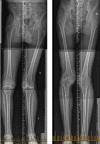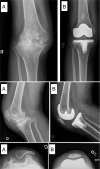Primary total knee arthroplasty in hemophilic arthropathy
- PMID: 37909693
- PMCID: PMC10646519
- DOI: 10.1530/EOR-23-0101
Primary total knee arthroplasty in hemophilic arthropathy
Abstract
Advanced hemophilic knee arthropathy is a frequent and devastating manifestation of severe hemophilia with significant implications for activities of daily living. Hemophilic arthropathy is caused by repeated bleeding, resulting in joint degeneration, pain, deformity and disability. In patients with hemophilia and advanced disease, total knee arthroplasty (TKA) has proven to be the most successful intervention, improves physical function and reduces knee pain. Hemophilic patients carry additional risks for complications and required specific pre/postoperative considerations. Expert treatment center should be used to improve patient outcome. Hemophilic patients present significant surgical challenges such as joint destruction, bone loss, severe ankylosis and oligoarticular involvement. The surgeon performing the arthroplasty must be experienced to manage such problems.
Keywords: complications; hemophilia; hemophilic arthropathy; knee; outcomes; total knee arthroplasty.
Conflict of interest statement
The authors declare that there is no conflict of interest that could be perceived as prejudicing the impartiality of the research reported.
Figures




References
Publication types
LinkOut - more resources
Full Text Sources

